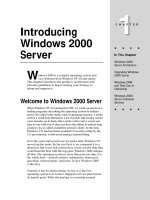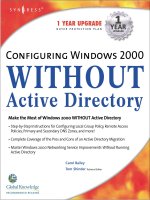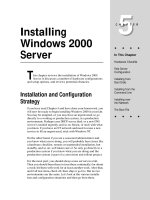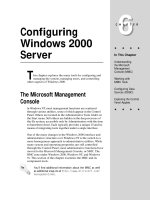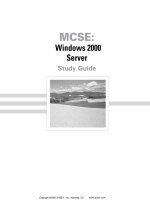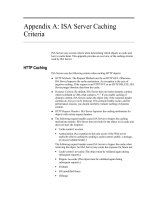Tài liệu Configuring Exchange 2000 Server pdf
Bạn đang xem bản rút gọn của tài liệu. Xem và tải ngay bản đầy đủ của tài liệu tại đây (7.35 MB, 671 trang )
FREE
.net™
Enterprise
Server Training DVD
FREE Palm OS Version
of Book
FREE Downloadable
HTML
FREE MP3 Audio Files
Liz Mason, MCSE, MCT, CTT
William Lefkovics, MCSE, A+
William C. Wade III, MCSE, MCT
WIN A PALM Vx !
DETAILS ON BACK
EXCHANGE
2000 SERVER
CONFIGURING
“The ultimate resource for managing
Exchange 2000 in the enterprise. This
book contains valuable insights.”
—Ed Brovick,
Director, Cambridge Technology Partners
With over 1,500,000 copies of our MCSE, MCSD, CompTIA, and Cisco
study guides in print, we have come to know many of you personally. By
listening, we've learned what you like and dislike about typical computer
books. The most requested item has been for a web-based service that
keeps you current on the topic of the book and related technologies. In
response, we have created
, a service that
includes the following features:
■
A one-year warranty against content obsolescence that occurs as
the result of vendor product upgrades. We will provide regular web
updates for affected chapters.
■
Monthly mailings that respond to customer FAQs and provide
detailed explanations of the most difficult topics, written by content
experts exclusively for
.
■
Regularly updated links to sites that our editors have determined
offer valuable additional information on key topics.
■
Access to “Ask the Author”™ customer query forms that allow
readers to post questions to be addressed by our authors and
editors.
Once you’ve purchased this book, browse to
www.syngress.com/solutions.
To register, you will need to have the book handy to verify your
purchase.
Thank you for giving us the opportunity to serve you.
128_Exch_FM 2/2/01 1:34 PM Page i
128_Exch_FM 2/2/01 1:34 PM Page ii
CONFIGURING
EXCHANGE 2000 SERVER
128_Exch_FM 2/2/01 1:34 PM Page iii
Syngress Publishing, Inc., the author(s), and any person or firm involved in the writing, editing, or production
(collectively “Makers”) of this book (“the Work”) do not guarantee or warrant the results to be obtained from the
Work.
There is no guarantee of any kind, expressed or implied, regarding the Work or its contents. The Work is sold
AS IS and WITHOUT WARRANTY. You may have other legal rights, which vary from state to state.
In no event will Makers be liable to you for damages, including any loss of profits, lost savings, or other inci-
dental or consequential damages arising out from the Work or its contents. Because some states do not allow
the exclusion or limitation of liability for consequential or incidental damages, the above limitation may not
apply to you.
You should always use reasonable case, including backup and other appropriate precautions, when working
with computers, networks, data, and files.
Syngress Media® and Syngress® are registered trademarks of Syngress Media, Inc. “Career Advancement Through
Skill Enhancement™,” “Ask the Author™,” “Ask the Author UPDATE™,” “Mission Critical™,” and “Hack
Proofing™” are trademarks of Syngress Publishing, Inc. Brands and product names mentioned in this book are
trademarks or service marks of their respective companies.
KEY SERIAL NUMBER
001 58P6DNSDSE
002 XPSPPL35C4
003 C3NMCF6FV7
004 P95C87BC2W
005 A4PCA94D55
006 6762RALTHG
007 Z7P8K522Q5
008 KUDJKE3427
009 7HSW2E947J
010 36GRMPS272
PUBLISHED BY
Syngress Publishing, Inc.
800 Hingham Street
Rockland, MA 02370
Configuring Exchange 2000 Server
Copyright © 2001 by Syngress Publishing, Inc. All rights reserved. Printed in the United States of America.
Except as permitted under the Copyright Act of 1976, no part of this publication may be reproduced or dis-
tributed in any form or by any means, or stored in a database or retrieval system, without the prior written per-
mission of the publisher, with the exception that the program listings may be entered, stored, and executed in a
computer system, but they may not be reproduced for publication.
Printed in the United States of America
1 2 3 4 5 6 7 8 9 0
ISBN: 1-928994-25-3
Copy edit by: Joeth Barlas, Darlene Bordwell, Developmental Editor: Kate Glennon
and Nancy Hannigan Freelance Editorial Manager: Maribeth Corona-Evans
Technical edit by: Liz Mason and Bill Wade Acquisitions Editor: Catherine Nolan
Technical review by: Neil Hobson Index by: Robert Saigh
Co-Publisher: Richard Kristof Page Layout and Art by: Shannon Tozier
Distributed by Publishers Group West
128_Exch_FM 2/2/01 1:34 PM Page iv
v
Acknowledgments
We would like to acknowledge the following people for their kindness and sup-
port in making this book possible.
Richard Kristof, Duncan Anderson, David Marini, Jennifer Gould, Kevin
Murray, Dale Leatherwood, Laura Cervoni, and Rhonda Harmon of Global
Knowledge, for their generous access to the IT industry’s best courses,
instructors, and training facilities.
Ralph Troupe, Rhonda St. John, and the team at Callisma for their invaluable
insight into the challenges of designing, deploying and supporting world-class
enterprise networks.
Karen Cross, Lance Tilford, Meaghan Cunningham, Kim Wylie, Harry
Kirchner, Bill Richter, Kevin Votel, Brittin Clark, and Sarah MacLachlan of
Publishers Group West for sharing their incredible marketing experience and
expertise.
Mary Ging, Caroline Hird, Simon Beale, Caroline Wheeler, Victoria Fuller,
Jonathan Bunkell, and Klaus Beran of Harcourt International for making cer-
tain that our vision remains worldwide in scope.
Anneke Baeten, Annabel Dent, and Laurie Giles of Harcourt Australia for all
their help.
David Buckland, Wendi Wong, Daniel Loh, Marie Chieng, Lucy Chong, Leslie
Lim, Audrey Gan, and Joseph Chan of Transquest Publishers for the enthu-
siasm with which they receive our books.
Kwon Sung June at Acorn Publishing for his support.
Ethan Atkin at Cranbury International for his help in expanding the Syngress
program.
Joe Pisco, Helen Moyer, and the great folks at InterCity Press for all their help.
Stephen Chetcuti at www.msexchange.org.
v
128_Exch_FM 2/2/01 1:34 PM Page v
vi
From Liz Mason,
Contributor and Technical Editor
I would like to thank Syngress Publishing, especially Kate Glennon, Catherine
Nolan, and Andrew Williams for their professionalism, patience, and assis-
tance. You are a quality team of publishers.
I would also like to thank Bill Wade for his reviewing skills and Paul Salas for
his insight and moral support.
The authors of this book worked very hard and produced some great content.
Congratulations on a job well done.
A special thank you goes to the MicroStaffers that helped out during writing
and editing days: Mickey Owens, Tan McGill, and Gale Porterfield, Ken Meece
(MCSE, MCT) and Alex Cook (MCSE, MCT) for their clustering and Exchange
assistance and David Smith (MCSE, MCT) for his time diagramming and
editing.
Thank you to Trevor and Michelle for your support over the holidays. Thank
you to Mom and Dad for your love. Thank you to Flossie for your kindness,
consideration, and willingness to help. Most importantly, all my love and
appreciation to my understanding and supportive husband Geoff and our
wonderful son Liam.
128_Exch_FM 2/2/01 1:34 PM Page vi
vii
From Global Knowledge
At Global Knowledge we strive to support the multiplicity of learning styles
required by our students to achieve success as technical professionals. As
the world's largest IT training company, Global Knowledge is uniquely
positioned to offer these books. The expertise gained each year from pro-
viding instructor-led training to hundreds of thousands of students world-
wide has been captured in book form to enhance your learning experience.
We hope that the quality of these books demonstrates our commitment to
your lifelong learning success. Whether you choose to learn through the
written word, computer based training, Web delivery, or instructor-led
training, Global Knowledge is committed to providing you with the very
best in each of these categories. For those of you who know Global
Knowledge, or those of you who have just found us for the first time, our
goal is to be your lifelong competency partner.
Thank your for the opportunity to serve you. We look forward to serving
your needs again in the future.
Warmest regards,
Duncan Anderson
President and Chief Executive Officer, Global Knowledge
128_Exch_FM 2/2/01 1:34 PM Page vii
128_Exch_FM 2/2/01 1:34 PM Page viii
ix
Contributor and Technical Editor
Liz Mason (MCSE, MCT, CTT) is founder and CEO of MicroStaff
Information Technology (www.microstaffit.com), a consulting and
training firm specializing in Microsoft BackOffice services. Liz
has not strayed far from the server room in the past 18 years:
She worked for NCR Corporation, starting in 1984, where she
did development on MailReady, a C/UNIX messaging product. At
NCR, she performed a variety of technical functions, from devel-
oping and maintaining NCR’s UNIX SVRV.4 operating system,
utilities, and applications, to international support for LAN/WAN
communications. When Microsoft introduced Windows NT, NCR
assigned a team to the BackOffice products, and Liz was given
EMS/Exchange. She has worked closely with the Exchange per-
formance team at Microsoft for nearly two years on under-
standing server scalability and performance issues.
In 1995, Liz founded MicroStaff, a Microsoft Solution Provider
and Certified Technical Education Center. From her first project
in Exchange migration at Shell Oil, to supporting and training
the military, various government agencies, and Fortune 500
companies, Liz has continued to take on roles of support ana-
lyst, trainer, author, administrator, and consultant for Exchange
and clustering. Liz was co-author for Exchange Administrator
Survival Guide (Exchange 4.0). She has also developed three
courses on Clustering for Windows NT utilizing Exchange and
SQL, two administrator courses on Exchange 5.0 and 5.5, as
well as end-user manuals for Microsoft Outlook. She, and the
team at MicroStaff, has focused on supporting and educating
their clients on Exchange, clustering, Windows NT/2000, IIS,
SMS, and disaster recovery.
128_Exch_FM 2/2/01 1:34 PM Page ix
x
William Lefkovics (MCSE, A+) is currently employed as a
Systems Analyst and Messaging Solution Developer at AscentrA,
a group of innovative healthcare companies in the Southwestern
US. He is the Microsoft specialist on an IT team supporting a
diverse multi-platform environment. Williams has previously
worked in data retrieval in an AS/400 environment for a large
retailer, as well as in Information Systems and inventory control
in a manufacturing environment. William holds an Associate
Certificate in Network Engineering from the British Columbia
Institute of Technology and hosts an Exchange website, which
can be found at www.exchange2000admin.com. William is active
in many Exchange-related newsgroups and can be reached at
William started with computers composing
ASCII adventure games in Basic on a Commodore 64 in 1982 in
his home town of 100 Mile House, BC, Canada. He is currently a
resident of Las Vegas, NV, and grateful to share his life with his
wife, Bertina.
Melissa Craft (CCNA, MCSE, Network+, MCNE, Citrix CCA) is
Director of e-Business Offering Development for CompuCom.
CompuCom provides IT design, project management, and sup-
port for distributed computing systems. Melissa is a key contrib-
utor to the business development and implementation of
e-business services. As such, she develops enterprise-wide tech-
nology solutions and methodologies focused on client organiza-
tions. These technology solutions touch every part of a system’s
lifecycle—from network design, testing and implementation to
operational management and strategic planning.
Melissa holds a bachelor’s degree from the University of
Michigan and is a member of the IEEE, the Society of Women
Engineers, and American MENSA, Ltd. Melissa currently resides
Contributors
128_Exch_FM 2/2/01 1:34 PM Page x
xi
in Glendale, AZ with her family, Dan, Justine, and Taylor.
Melissa is the author of Syngress Publishing’s best-selling
Managing Active Directory for Windows 2000 Server (ISBN:
1-928994-07-5).
Brian Barber (MCSE, MCP+I, MCNE, CNE-5, CNE-4, CAN-3,
CNA-GW) is a Senior Technology Consultant with Sierra Systems
Consultants Inc. in Ottawa, Canada. He provides technical
architecture consulting and analysis to public and private sector
clients in the National Capital Region. Brian specializes in
Internet, intranet, and extranet technologies, focusing on Web-
enabled service delivery through directory services and mes-
saging. His background includes positions as Senior Technical
Analyst at MetLife and Senior Technical Coordinator at the LGS
Group Inc. (now a part of IBM Global Services). He would like to
thank his beautiful wife, Rosemary, and daughter, Miranda, for
all of their love and support, Hugh for encouraging him to tackle
this project, and Blair Cribb and Scott Fraser at Microsoft Canda
for providing everything he needed to set up his lab.
Neil Hobson (MCSE, CLP) is a Senior Messaging Consultant with
Silversands, a UK-based Microsoft Solutions Provider Partner,
and has been in the messaging field for over six years. Neil is
responsible for the design, implementation, and support of cor-
porate messaging systems across the UK and Europe and is pri-
marily focused on implementing Microsoft Exchange solutions.
His clients include Barclays Bank plc, Hays plc, and the Royal
Borough of Kensington & Chelsea. Neil currently resides in
Weymouth, England, with his family Sally, Corinna, and Amber.
Steve Schwartz (MCSE, MCT) is the founder and Principal
Engineer of Implement.com, LLC, a consulting and training com-
pany based in Seattle, WA. Steve was one of the first MCSEs,
obtaining his certification in April, 1994 and has been an MCT
128_Exch_FM 2/2/01 1:34 PM Page xi
xii
since 1993. He has over 12 years of experience implementing
enterprise scale systems and training individuals and companies
to do the same. He has a broad range of consulting and teaching
experience, including training internal Microsoft support and
consulting personnel in Europe, South America, Asia, the Middle
East, and the United States. He can be reached at
Steve resides in Seattle, WA.
Keith Boesel (MCSE+I, CCNA) is a Technical Professional with
TEKsystems in Phoenix, AZ. He specializes in designing and
deploying business solutions based on Windows NT/2000,
Exchange, and Cisco. Keith has also worked with IKON Office
Solutions, MicroAge, and General Electric. He has a BS degree in
Computer Engineering from The Ohio State University. He lives
in Chandler, AZ with his very patient wife, Dorothy.
William C. Wade III (MCSE, MCT) has been a Networking and
Systems Consultant for ten years. He has worked for several
solution providers, where he gained experience implementing
Microsoft solutions for organizations of all shapes and sizes.
Today, as a principle of Wadeware LLC, Bill works closely with
Microsoft and other companies on Windows 2000 and Exchange
2000 projects. On these subjects he has written numerous arti-
cles, white papers, and MOC courses. He is also the author of
two books, including Implementing Exchange Server. He resides
in Issaquah, WA.
128_Exch_FM 2/2/01 1:34 PM Page xii
Contents
xiii
Foreword xxvii
Chapter 1 What’s New in Exchange 2000 1
Introduction 2
Product Versions and Components 2
Exchange 2000 Server 3
Exchange 2000 Enterprise Server 4
Exchange 2000 Conferencing Server 4
Overview of Features 4
Windows 2000 and Active Directory Integration 5
Windows 2000 Security 5
Active Directory Connector 5
Microsoft Management Console Integration 6
Using the Help Files 8
Server Features 8
Multiple Information Stores 8
Transaction Logs 9
Installable File System 10
The Web Store 10
Storage Groups and Multiple Message Stores 11
Multiple Public Folder Trees 14
On-Demand Content Conversion 14
Policy Settings for Information Stores 15
Clustering 15
Routing and Networking Features 15
SMTP Routing of Messages between Servers 16
Integration with Internet Information Services 16
Improved System Monitoring of Exchange 16
Message Restrictions to Reduce Spamming 17
Client Features 17
Increased Protocol Support 18
Outlook 2000 and Outlook for Macintosh 8.2.2 18
Accessing the Exchange Store from Microsoft Office and
Win32-Compliant Utilities 19
128_Exch_ToC 2/2/01 2:04 PM Page xiii
xiv Contents
Accessing the Exchange Store from Browsers 19
Searching the Exchange Store Faster 20
Development Changes and Features 20
Application Development 21
OLE DB 2.5 Support 21
Utilization of Web Store Content in Web Sites 21
Event Modeling and Workflow Improvements 21
Advanced Concepts and Implementations 21
Instant Messaging 22
Chat Services 22
Data and Video Conferencing 22
Conferencing and Real-Time
Communication Clients 23
Application Service Provider and
Internet Service Provider Solutions 23
Exchange 2000 Resource Requirements 23
Exchange 2000 Resource
Minimum Requirements 24
Exchange 2000 Resource
Recommended Requirements 24
Exchange 2000 Licensing 25
Summary 25
FAQs 26
Chapter 2 Active Directory Integration
with Exchange 2000 29
Introduction 30
Why Use Exchange 2000 on Active Directory 30
The Role of Active Directory in Exchange 2000 32
Exchange Server’s Need for a Directory Service 32
Understanding Active Directory Architecture 32
Hierarchical Structure 33
Domain Trees 34
Organizational Unit Tree Structure 36
Global Catalog 37
Storage 39
Internet Standard Protocols 42
Domain Name System 42
Lightweight Directory Access Protocol (LDAP) 45
Kerberos Version 5 46
Replication 46
Policies 49
Working with the Architectural Details 49
How Exchange Connects to Active Directory 52
Administrative Tools 53
128_Exch_ToC 2/2/01 2:04 PM Page xiv
Contents xv
Planning for Active Directory 55
Sizing Domain Controllers 55
Exchange Server’s Impact on Design 56
Forest 59
Domains/DNS 62
Organizational Units 65
Sites 66
Implementing Active Directory and Exchange 2000 69
DCPromo 69
Active Directory Connector 72
ForestPrep 74
DomainPrep 78
Setting Up Your Active Directory 80
Troubleshooting Exchange 2000 during Implementation 82
Problems with the DNS 82
Active Directory Connector 84
ForestPrep and Site Configuration 85
Removing an Exchange Server from the Active Directory 86
More Information 87
Summary 87
FAQs 89
Chapter 3 Security Applications that
Enhance Exchange 2000 91
Introduction 92
Understanding Your Security Needs 93
What Needs to Be Protected? 93
Who Is the Enemy? 93
What Are We Protecting Against? 95
Impersonation and Forgery 95
Unauthorized Access to the Corporate Infrastructure 97
Viruses 97
How Do We Protect Ourselves? 98
Windows 2000 and Exchange 2000 Security Architecture 101
Active Directory 101
Public Key Infrastructure 102
Public Key Infrastructure and Active Directory 102
Digital Certificates 103
Certification Authority 103
Digital Envelopes 103
Secure Networking 104
Client Access 105
Windows 2000 and Exchange 2000 Internal Security 106
Protocols 106
NT LAN Manager 107
128_Exch_ToC 2/2/01 2:04 PM Page xv
xvi Contents
Kerberos 109
Secure Sockets Layer 111
Certificates 112
Delegation in Exchange 116
Integrating Roles 116
Separating Roles 116
Permissions 117
Administration Delegation Wizard 117
Roles 118
Levels of Administration 119
IPSec 121
Security Policies 122
Account Policies 123
Group Policy 124
IP Security Policies 125
Firewalls 125
Firewall Strategies and Exchange 2000 127
Firewall Placement 127
Firewall Administration 131
Configuring Client Security 131
Securing Outlook 131
Encrypting File System 131
Securing Web Browsers 133
User Authentication 133
Encryption 136
Implementing a Smart-Card Environment 138
Authentication 139
Interactive Logon 139
Logon Request 139
Offline Logon 140
Smart Cards and Exchange 2000 Security 140
Summary 141
FAQs 142
Chapter 4 Basic Administration 145
Introduction 146
Exchange Administration Tools 149
Active Directory Users and Computers 150
Exchange System Manager 152
Administering Users, Contacts, and Groups 153
Administering User Accounts 155
Creating Mailbox-Enabled User Accounts 155
Configuring User Account Properties 157
Mailbox-Enabling an Existing User Account 167
128_Exch_ToC 2/2/01 2:04 PM Page xvi
Contents xvii
Administering Contacts 168
Creating Mail-Enabled Contacts 168
Administering Groups in Exchange 2000 171
Considering Administrative and Routing Groups 171
Managing Security and Distribution Groups 173
Mail-Enabling an Existing Security Group 177
Administering Exchange Server 179
Configuring Exchange Global Settings 180
Administering Address Lists 181
Managing Online Address Lists 182
Default Address Lists 182
Creating Custom Address Lists 184
Editing and Removing Address Lists 184
Setting Client Permissions for Online Address Lists 186
Managing Offline Address Lists 187
Creating Offline Address Lists 187
Editing and Removing Offline Address Lists 189
Rebuilding Offline Address Lists 189
Customizing Address Book Templates 190
Managing Policies on Exchange 2000 191
Administering System Policies 192
Configuring Server Policy 192
Configuring Mailbox Store Policy 194
Configuring Public Store Policy 197
Administering Recipient Policies 198
Creating a New Recipient Policy 199
Changing Recipient Policy Priority 200
Forcing Recipient Policy Updates 201
Administering Exchange Server Protocols 201
Configuring SMTP Virtual Servers 203
Configuring IMAP4 and POP3 Virtual Servers 207
Managing Exchange Data Storage 207
Administering Mailbox Stores 207
Administering Public Folders 212
Maintaining Public Folder Store 212
Managing Connectors 213
Configuring Routing Group Connectors 214
Configuring SMTP Connectors 216
X400 Connectors 218
Connectors to Foreign Systems 218
Summary 219
FAQs 220
128_Exch_ToC 2/2/01 2:04 PM Page xvii
xviii Contents
Chapter 5 Client Access to Exchange 2000 for E-Mail 223
Introduction 224
Physical Access 224
Local Area Networks 226
Wide Area Networks 227
Dial-Up Connections 228
Virtual Private Networks 230
VPN Authentication and Encryption
Protocol Considerations 231
VPN Security Considerations 234
Using Windows 2000 Routing and
Remote Access Servers 237
Clients 237
MAPI Clients 238
Outlook 2000 240
Outlook 98 252
Outlook Web Access Clients 252
Migrating from Exchange 5.5 OWA 255
Outlook Web Access Authentication 256
Exchange Server Placement 259
Internet Explorer, Version 5 262
Netscape Navigator 263
POP3 and IMAP4 Clients 264
Migrating a POP3 Client to Use
Exchange 2000 Server 264
Outlook Express 264
Netscape Navigator Mail 266
Eudora 267
LDAP Clients 268
LDAP Background 268
Outlook Express LDAP 270
Troubleshooting 271
Stuck in the Middle of the Outbox 272
The Missing Files 272
POP3 Oddities 273
User Misunderstanding 273
Attachments 274
Protocol Logging 274
Summary 275
FAQs 276
Chapter 6 Deploying Exchange 2000 Server 279
Introduction 280
Green Field Deployment 281
Preparing Active Directory 281
128_Exch_ToC 2/2/01 2:04 PM Page xviii
Contents xix
Using ForestPrep 282
Preparing Your Domains 285
Using DomainPrep 285
Deploying Servers Running Exchange 2000 287
Establishing the First Administrative Group 287
Deploying Exchange Using Terminal Services 288
Deploying Support for Multiple Languages 289
Deploying Exchange on a Windows 2000 Cluster 290
Unattended Installation 291
Deploying Exchange System Manager 292
Upgrading from Previous Versions of Exchange 292
Upgrading the Directories to Active Directory 293
When to Consolidate before Deploying 297
Tools Used to Upgrade the Windows NT 4.0 SAM 298
Using the Active Directory Migration Tool 298
Tools Used to Upgrade the Exchange
Server 5.5 Directory 299
Using the Active Directory Connector 299
Site Replication Service 305
Using the Active Directory Account Cleanup Wizard 306
Directory Upgrade Scenarios 307
Using the In-Place Upgrade Method 307
Upgrade Using ADMT then ADC 308
ADC then In-Place Upgrade then ADClean 309
Upgrade Using ADC then ADMT then ADClean 312
Directory Upgrade Considerations 314
When to Require a Native Mode Domain 315
How to Successfully Use Universal Groups 316
Upgrading the Messaging Environment 317
Performing an In-Place Upgrade 318
Performing a Move-Mailbox Upgrade 318
Using the Leapfrog Method 319
Moving to a New Organization 321
Using the Exchange Mailbox Migration Program 321
Upgrading Supporting Servers 321
Upgrading Connector Servers 322
Upgrading Client Access Using Front-end Servers 323
Testing Your Scenario 323
Summary 324
FAQs 327
Chapter 7 Defending Exchange 2000 from Attack 329
Introduction 330
What Are the Potential Threats to Exchange 2000? 330
Unsolicited Commercial E-Mail 331
128_Exch_ToC 2/2/01 2:04 PM Page xix
xx Contents
Considering Defense Strategies 332
Setting Policy 332
Educating Users 333
Protecting the Message Store 334
Physical Security 334
Antivirus Protection for Exchange 334
Vendor Solutions 338
Client-Side Protection 341
Protecting the Workstation 341
Protecting the Outlook Client 341
Microsoft Outlook Security Patch 343
Vendor Solutions 345
Firewall and Gateway Strategies 346
Point of Entry Protection 347
Handling Inbound UCE 347
Vendor Solutions 348
Preventing Unwanted SMTP Mail Relay 349
Configuring SMTP Protocol Logging 351
Hosting 352
Managing Exchange 2000 Security 352
Summary 353
FAQs 354
Chapter 8 Real-Time Communication
in Exchange 2000 355
Introduction 356
The Value of Instant Messaging to Your Business 356
Architecture 357
MSN Messenger Service 357
Exchange 2000 Instant Messaging Client 357
Exchange 2000 Instant Messaging Server 358
Before You Install Your Instant Messaging Servers 360
Implementing Instant Messaging 361
User Administration 363
Client Configuration 365
Troubleshooting 365
Using Chat Services 366
Implementing Chat Services 366
Server-Side Installation 367
Client-Side Configuration 370
Troubleshooting Chat 370
Can Conferencing Server Keep Your Travel Budget Down? 372
Background 373
Components 373
Reserving a Conference Room 375
128_Exch_ToC 2/2/01 2:04 PM Page xx
Contents xxi
Joining and Managing Conferences 376
Installing Exchange Conferencing Server 379
Configuration 380
Server Side Configuration 381
Client-Side Configuration 387
Troubleshooting 391
More Information 394
Summary 394
FAQs 395
Chapter 9 Application Service Providers 397
Introduction 398
Defining Application Service Providers 398
ASP Definitions 398
ASP Messaging Service Models 400
Dedicated Service Model 400
Shared Service Model 400
Hosting Services Using Exchange 2000
and Active Directory 401
Using Exchange 2000 to Host Basic Messaging 401
Using Exchange 2000 to Host Premium Messaging 402
Using Exchange 2000 to Host Basic Web Messaging 402
Using Exchange 2000 to Host
Premium Web Messaging 402
Hosting Other Services Integrated
with Exchange 2000 and Active Directory 403
Exchange 2000 Conferencing Server 403
Exchange 2000 Instant Messaging 403
Custom Applications 403
Third-Party Add-ons 403
Architecture for Shared Hosting 404
Architectural Overview 404
DMZ 404
Back-end Servers 407
Scaling Exchange 2000 and Active Directory 409
Planning and Configuring the Active Directory
and Exchange 2000 Hosting Infrastructure 410
Windows 2000 and Active Directory 411
Forest and Domains 411
Domain Controllers and Global Catalogs 411
User Identification 411
Creating Organizational Units 413
Configuring Security Groups 413
Securing Organization Units 414
128_Exch_ToC 2/2/01 2:04 PM Page xxi
xxii Contents
Configuring Exchange 2000 417
Configuring Front-end Exchange 2000 Servers 417
Configuring Recipient Policies 417
Configuring SMTP Connectors 420
Configuring Address Lists 421
Configuring POP3/IMAP4 426
Configuring HTTP 426
Configuring Storage Groups 429
Security Considerations 430
Additional Resources 430
Summary 430
FAQs 431
Chapter 10 Is Your Backup and Restore Really Working? 433
Introduction 434
Exchange 2000 Architecture Overview 434
Database Components 434
Transaction Logging 435
Internet Information Server 436
Certificate Authority/Key Management Server 437
Site Replication Service 437
Exchange 2000 Back Up Basics 438
Online Backups 438
Offline Backups 438
Exchange 2000 Restore Basics 438
Restoring Individual Mailboxes 440
Tools and Products to Back Up Your Exchange 2000 Data 441
NTBackup 441
Third-Party Backup Products 442
ExMerge Utility 443
Mailbox Recovery and Deleted Item Recovery 443
Types of Backup Procedures 443
Normal Backups 444
Differential Backups 445
Incremental Backups 445
Copy Backups 445
When to Back Up 446
Preventing Data Loss: What to Back Up and Why 447
Types of Data to Back Up 447
Types of Losses 448
Planning Data Loss Prevention and Recovery 450
Backup Devices 450
Tape Library 450
Local Tape Drives 451
Backup to a File 451
128_Exch_ToC 2/2/01 2:04 PM Page xxii
Contents xxiii
Best Practices for Backups and Restores 451
Test Your Backups Monthly 451
Consider Services Related to Exchange 452
Keep Half Your Database Drive Space Free 452
Keep an Eye on the Backup Logs 452
Keep an Eye on the Event Logs 452
Document Your Exchange Network 454
Have Components in a Central Location 454
Have Backup Hardware Standing By 454
Store Backup Tapes at a Safe Offsite Location 455
Implementing Backup 455
Using NTBackup to Back Up Exchange Databases 455
Using NTBackup for Other Exchange Databases 457
Backing Up Other Services 457
Internet Information Services 457
Certificate Authority 458
Using ExMerge to Back Up Mailboxes 458
Test Your Backups 459
Implementing Restore Scenarios 460
Restoring an Exchange 2000 Server 460
Performing a Full Restore 460
Restoring a Corrupted Database 460
Restoring the KMS and CA Databases 462
Restoring the Site Replication Service 462
Restoring the Active Directory 463
Deleted Mailbox Recovery 464
Deleted Item Recovery 464
From Brick-Level Backup 465
From ExMerge 465
From a Complete Database Restore 465
Restoring an Exchange Connector 467
Troubleshooting 468
Understanding the LegacyExchangeDN Identifier 468
Backup Problems 470
Corrupted Database 470
Errors in the Backup Log 471
Summary 471
FAQs 472
Chapter 11 Clustering Your Exchange 2000 Server 473
Introduction 474
Understanding Cluster Service and NLBS 475
What Is Microsoft Cluster Service? 476
What Is Network Load Balancing? 476
128_Exch_ToC 2/2/01 2:04 PM Page xxiii
xxiv Contents
Architecture 478
Cluster Service Basics 478
Quorum Drives 479
Networking Details 480
Resource Groups 480
The Failover Process 482
Exchange 2000 Cluster Basics 484
Network Load Balance Basics 485
Advanced Exchange Clustering 489
Active/Active Clusters 490
Datacenter Server 493
Planning Your Exchange Cluster 495
When to Use Clustering 495
When Not to Use Clustering 496
Database Corruption 496
Service Startup Time 496
Load Balancing Information Stores 497
Database Maintenance 497
Extra Work 497
Capacity Planning 497
Exceed Storage Group Limit During Failure 499
The Failback Option 500
Using Cluster Utilities 500
Installing an Exchange Cluster 501
Building a New Windows 2000 Cluster 501
Installing Exchange 2000 on a Cluster 509
How to Upgrade from an Exchange 5.5 Cluster 515
How to Install and Configure Network Load Balancing 518
Troubleshooting 518
Database Corruption 518
Quorum Drive Failure 519
Accidentally Stopping an Exchange Service 519
Summary 520
FAQs 521
Chapter 12 Basic Monitoring and Troubleshooting
Methodology 523
Introduction 524
Basic Troubleshooting Methodology for Exchange 2000 526
Wait and Refresh 526
Know Your Services 526
Event Viewer Logs 529
Diagnostic Logging 530
Monitoring Services and Objects 531
128_Exch_ToC 2/2/01 2:04 PM Page xxiv

